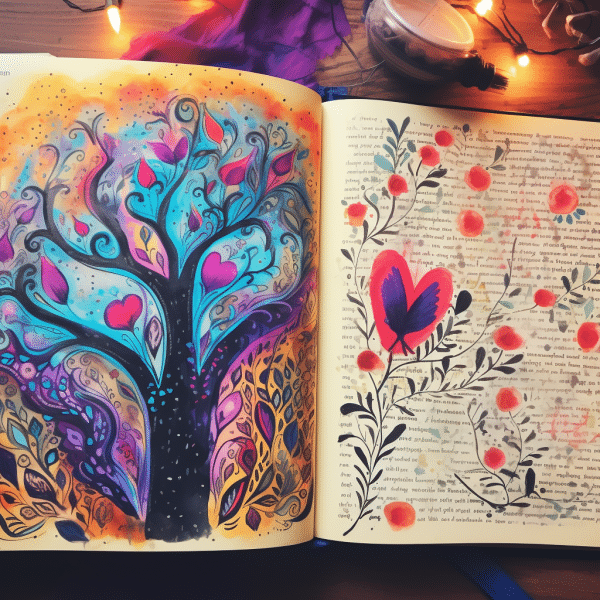
 Bible journaling is becoming a popular therapeutic practice. Combining art and scripture, it offers a special way to process trauma. It helps people explore their emotions and experiences through art. Self-reflection and introspection are encouraged. This journey leads to healing and growth.
Bible journaling is becoming a popular therapeutic practice. Combining art and scripture, it offers a special way to process trauma. It helps people explore their emotions and experiences through art. Self-reflection and introspection are encouraged. This journey leads to healing and growth.
This tool has ancient roots. Through the ages, people have found comfort and guidance in sacred texts. Bible journaling continues this tradition with a modern approach. It’s an outlet for emotional expression and healing.
What is Bible journaling?
Bible journaling is a special way of combining art and spirituality. It lets people interact with Bible passages by adding personal reflections, illustrations, and prayers to their Bible or in a special journal. This interactive approach to studying and meditating on scripture can be healing, connecting, and self-expressing.
By engaging in Bible journaling, individuals can explore their unique relationship with faith and spirituality through visuals. This might mean painting, sketching, hand-lettering, or collaging. Making something visually appealing while thinking about Bible verses can be therapeutic for emotions and thoughts caused by trauma.
Bible journaling is versatile. There are no rules or guidelines on how to do it. Each person can interpret and react to scripture in ways that fit them. This freedom lets people tailor their journaling experience to their individual needs and preferences.
To use Bible journaling for trauma healing, here are some tips:
- Choose meaningful passages: Pick Bible verses that relate to your trauma experiences or problems. Reflect on these verses when incorporating them into your journal.
- Express emotions through art: Use colors, pictures, and symbols that represent your trauma emotions. Visually expressing these feelings can be very relieving.
- Write affirmations: As well as illustrating Bible verses, write positive phrases that help counteract negative thoughts or beliefs caused by trauma. Saying these affirmations during the creative process can bring healing.
- Journal alongside professional therapy: Bible journaling can help with trauma, but it’s important to seek professional help too. Consider using it as a complement to therapy sessions.
By using these practices in Bible journaling, individuals can find comfort, healing, and personal growth in their recovery from trauma. Keep an open mind and give yourself permission to explore and freely express your emotions.
The Healing Power of Art
Art as a Healing Force:
Art has the potential to bring healing and restoration to those who have experienced trauma. Through visual expression and creativity, individuals can find solace, process emotions, and regain a sense of control. Art can serve as a vehicle for catharsis, allowing individuals to delve into their experiences and release pent-up emotions in a healthy and productive way.
Unlocking Emotional Expression:
Art provides a unique avenue for individuals to express complex feelings and experiences that may be difficult to put into words. It taps into the subconscious, allowing for the emergence of buried emotions and memories. This creative process can help individuals make sense of their trauma, gain new insights, and find a sense of resolution.
Empowerment and Control:
Engaging in art allows survivors of trauma to reclaim their power and regain a sense of control over their experiences. In the midst of trauma, individuals often feel helpless and overwhelmed. Creating art provides an outlet for self-expression, offering a tangible way to take control and assert agency over their own narratives.
Beyond Verbal Communication:
Communication through art transcends language barriers and focuses on the visual and sensory aspects of expression. This can be particularly beneficial for trauma survivors who may struggle to articulate their experiences verbally. Art allows for non-linear storytelling, capturing the complexity and nuances of trauma in a way that words often fail to capture.
The Healing Journey Continues:
Art therapy is an ongoing process that requires continued effort, commitment, and support. While individuals may find initial healing through the creation of art, it is crucial to seek professional guidance and support to further deepen the therapeutic benefits. By harnessing the healing power of art, individuals can embark on a journey of self-discovery, growth, and healing.
Discover the Healing Potential of Art:
Are you ready to tap into the transformative power of art? Embrace the opportunity to explore your journey of healing through creative expression. Don’t miss out on the chance to discover the profound impact art can have on your well-being. Take that first step towards healing today and unlock the healing power of art.
Unleash your inner artist and exorcise those demons with Bible journaling, because who needs therapy when you have coloring and scripture!
Art Therapy and Trauma Healing
Art therapy is a great healing tool! Creative expression is used to explore and process emotions without words. This allows for the release of blocked feelings, which leads to better self-awareness and emotional health.
In therapy sessions, participants paint, draw, and sculpt to express themselves. They create art that reflects their inner thoughts and emotions, in a safe environment. Art therapy has been proven to help trauma survivors. It can be hard to talk about traumatic experiences. Art supplies an alternative way to communicate and handle tough feelings.
The focus is on the creation process, not the product. There is no pressure to create a masterpiece. This encourages freedom and authenticity.
Art therapy also grants empowerment. Individuals can take back control of their story and find their voice. It can be a meaningful experience, aiding in rebuilding their sense of self.
Pro Tip: If you or someone you know has faced trauma, art therapy could be beneficial. Participating in the creative process can provide great therapeutic benefits and help with overall wellness. Ancient manuscripts are evidence of how art has been used as a tool for spiritual growth since ancient times. She used Bible texts to explain her feelings. Sarah eventually found comfort in focusing on scripture throughout her work. However, verses that speak about comfort, hope, strength, and God’s love can be particularly meaningful for trauma healing.
Using Bible Journaling for Healing from Trauma
Bible Journaling as a Therapeutic Approach for Trauma Recovery
Bible journaling can serve as a powerful tool in the healing journey from traumatic experiences. This unique form of self-expression combines reflection on scripture with creative expression through art, allowing individuals to process emotions, find solace, and cultivate a deeper connection with their faith.
By engaging in Bible journaling, individuals can tap into the healing power of storytelling, as the Bible provides narratives of resilience, transformation, and hope. Through the artistic process of journaling, trauma survivors can explore these stories in a personal and meaningful way, relating them to their own experiences and finding comfort in the shared human condition.
Moreover, Bible journaling offers a safe space for catharsis, enabling individuals to release pent-up emotions and express their innermost thoughts and feelings. The act of visually representing emotions and thoughts can facilitate the integration and processing of traumatic events, leading to increased self-awareness and emotional healing.
Furthermore, the hands-on nature of Bible journaling engages multiple senses, providing a grounding and soothing effect. As individuals engage in the tactile experience of manipulating art supplies and creating visual representations, they can experience a calming and meditative state, fostering relaxation and emotional regulation.
To make the most of Bible journaling for trauma healing, individuals can explore various suggestions. Firstly, selecting a specific verse or passage that resonates with their experiences can help channel emotions and provide a focus for reflection. Secondly, using a variety of artistic mediums, such as painting, drawing, or collaging, allows for diverse forms of expression. Finally, incorporating journaling alongside the visual elements can enhance self-reflection and provide a written record of the healing journey.
Who needs a therapist when you can just doodle your way to emotional stability?
Expressing Emotions through Art
Art transcends language barriers and touches our soul. It lets us explore difficult emotions without judgement. We can visually express what words cannot capture. It helps us understand our emotions and allows others to see our experiences.
It also helps us relax and be mindful. We focus and concentrate, which distracts us from troubling thoughts. Engaging in art involves using our senses, which promotes relaxation.
Sarah is a heart-warming example of the healing power of art. She experienced trauma and couldn’t find the words to express her pain. So, she painted. With each brushstroke, she released hurt and resentment.
Through art, Sarah regained control and redefined herself as a survivor. Art allowed her to confront her trauma and find healing, empowerment, and self-discovery. Creative expression is a powerful way to heal.
Reflecting on Scripture and Personal Experiences
Bible journaling is a great way to reflect. Read a passage, think about it, then write down or draw what it makes you feel. This way, you have a physical reminder of your healing experience.
Another option is to look at different Bible translations. Each one can give a different viewpoint. This can uncover new ideas, giving you comfort and guidance.
Community support is also key. Find a group with others who have gone through something similar. Share your stories and be inspired by each other, as well as scripture. This will help you find strength.
Finding Comfort and Strength in Faith
Trauma can feel overwhelming and lost. But faith brings peace and strength which exceeds our understanding. Bible journaling offers a unique way to engage with scripture. Writing verses, illustrations, or reflecting on the words, can lead to healing.
Traditional therapy helps, but Bible journaling provides another avenue for exploration and self-expression. It’s a safe space to share emotions and invite God. Choose themes or let creativity flow for clarity of thoughts and emotions.
Don’t miss out on the power of Bible journaling for trauma healing. Use this creative practice to find comfort, strength, and renewal. Be vulnerable when engaging with scripture and you may discover new insights, deeper connections with faith, and healing from past hurt.
Tips for Starting a Bible Journaling Practice
Starting a Bible Journaling Practice – Tips and Techniques
Bible journaling has become an increasingly popular method to engage with scripture by combining artistic expression and personal reflection. Here are six points to consider when starting a Bible journaling practice:
- Choose the right materials: Selecting quality materials, such as journaling Bibles, archival pens, and water-based paints, will ensure longevity and enhance your creative process.
- Set aside dedicated time: To fully immerse yourself in the practice, establish a regular schedule for Bible journaling. This allows you to focus on the process and engage more deeply with the passages you choose to explore.
- Select meaningful passages: Identify verses or passages that resonate with you personally. These can be words of encouragement, verses that speak to your current life experiences, or teachings you want to further explore through art.
- Plan your layout: Before starting, sketch out your ideas for the journal page. This helps create a cohesive visual representation of the chosen passage and ensures that the message is effectively conveyed through your artwork.
- Incorporate different techniques: Experiment with various techniques such as hand lettering, coloring, collage, and even mixed media. Incorporating different artistic styles and mediums can add depth and richness to your Bible journaling pages.
- Reflect and meditate: As you work on each page, take the time to reflect on the chosen passage and its meaning in your life. Journaling prompts and guiding questions can aid in this process, allowing you to connect with the text on a deeper level.
Unleashing Creativity and Nourishing the Soul
Bible journaling provides a unique opportunity for self-expression and spiritual growth. By combining art and scripture, this practice allows individuals to explore their faith in a creative and personal way. Give it a try and see how Bible journaling can become a powerful tool for reflection and healing.
One example of the impact of Bible journaling is the story of Sarah, who discovered this practice following a tragic loss in her life. Through Bible journaling, Sarah found solace and a renewed sense of connection with her spirituality. The process of creating art while meditating on scripture brought healing and transformation, allowing her to find comfort and hope in the midst of her grief. This true story highlights the profound impact that starting a Bible journaling practice can have on one’s emotional well-being and spiritual journey.
Choosing the perfect materials for Bible journaling is like finding the right therapist – it takes trial and error, but ultimately, it’s about finding what makes you feel better and not getting glitter in all the wrong places.
Selecting the Right Materials
To have an enjoyable Bible journaling practice, the right materials must be selected. Your chosen items can make a difference to your experience and the outcome of your journaling. Here are some tips to help you choose:
| Pens and Markers | Invest in pens and markers that won’t fade away. Ones that are acid-free will do the trick. |
| Journal or Notebook | Pick a journal or notebook with thicker pages so that your pens and markers don’t seep through. |
| Watercolor Paints | For watercolor fans, make sure they’re high quality and vibrant to get the desired effect. |
Also, use adhesive tabs or washi tape to mark pages. These decorations add beauty and practicality. Adding stickers or die-cuts with quotes or verses is also a great way to be creative.
Once you have these materials, you can have a strong basis for your Bible journaling practice. The pens and markers will let you express yourself without worrying about smudging or fading. The thicker pages will provide a sturdy surface for all art techniques. And with watercolor paints, adhesive tabs, washi tape, stickers, and die-cuts, you can show your unique interpretation of scripture.
But, it’s important to nurture your creative spirit while building a relationship with the Word of God too. Enjoy your journaling!
Creating a Safe Space for Journaling
Creating a safe haven for Bible journaling is key to a meaningful and sustainable practice. Make a corner of your home or a cozy nook that provides comfort, privacy and inspiration. This space should be comfortable, with soft lighting, comfy seating and soothing music.
In order to make the most of this space, it’s essential to cultivate emotional safety. Let go of judgement and self-criticism. Don’t strive for perfection – embrace imperfection and express your true self. This vulnerability and self-acceptance can open up deeper spiritual exploration and connection with God.
To add to the experience, introduce inspiring items. Decorate the space with quotes, photographs or objects that symbolize milestones in your faith journey. Use candles and oils for their calming properties.
History shows us the transformative power of this practice. Ancient manuscripts are evidence of how art has been used as a tool for spiritual growth since ancient times. She used Bible texts to explain her feelings. Sarah eventually found comfort in focusing on scripture throughout her work. However, verses that speak about comfort, hope, strength, and God’s love can be particularly meaningful for trauma healing.
Setting Realistic Expectations
When you start Bible journaling, set realistic expectations. Here are some tips:
- Work out your time: Find moments in your day for journaling.
- Start off simple: Build confidence with basic entries.
- Embrace mistakes: Bible journaling is about expressing yourself – mistakes are beautiful!
- Flexibility: Allow yourself to have different levels of inspiration and time.
- Personal growth: Focus on the spiritual insight from engaging with Scripture.
Everyone’s journey is unique. Find what works for you by experimenting.
Pro Tip: Join a community or attend workshops to meet other Bible journalers and get inspired.
Real-life Stories of Healing through Bible Journaling
Journalling for recovery.
Visuals to process trauma.
Finding ease in creative expression.
Personal stories of transformation.
Bible journaling heals many beyond these stories. This unique method uses scripture and art therapy to explore emotions and heal.
Sarah exemplifies. She started Bible journaling after a trauma. She used Bible texts to explain her feelings. Sarah eventually found comfort in focusing on scripture throughout her work. However, verses that speak about comfort, hope, strength, and God’s love can be particularly meaningful for trauma healing. Bible journaling helped her recover.

Conclusion
Bible journaling can be a powerful tool for healing trauma. It brings solace and restoration. Through reflection on scripture, individuals can find personal connection and deep introspection. Writing or drawing in a journal can give a sense of control and empowerment. This can bring about emotional and spiritual growth.
Moreover, Bible journaling offers an opportunity to engage with scripture. Combining art with biblical text helps explore interpretations and perspectives. This strengthens the connection to the Word. It encourages introspection and self-reflection. This can lead to healing and growth.
Pro Tip: Seeking guidance from experienced practitioners or joining supportive communities can help with Bible journaling for trauma healing. They offer accountability and foster a sense of belonging.
Frequently Asked Questions
1. Can Bible journaling really help with healing from trauma?
Yes, Bible journaling can be a powerful tool for healing from trauma. It provides a creative outlet to express emotions, encourages reflection on biblical texts, and promotes a sense of comfort and peace.
2. How does Bible journaling promote healing?
Bible journaling promotes healing by allowing individuals to engage with Scripture in a personal and creative way. The act of reflecting on verses, writing them down, and creating art around them can bring comfort, healing, and a sense of connection to a higher power.
3. Do I need to be artistically talented to practice Bible journaling for healing?
No, artistic talent is not a requirement for Bible journaling. It is a personal practice, and the focus should be on expressing emotions and connecting with the biblical texts. Simple doodles, writing, and coloring can be just as impactful as elaborate artwork.
4. Can Bible journaling replace professional therapy for trauma?
No, Bible journaling should not replace professional therapy. It can be used as a complementary practice to enhance healing, but it is important to seek professional help for trauma-related issues. Bible journaling can be a helpful addition to a holistic healing approach.
5. Are there specific Bible verses or themes that are helpful for trauma healing?
There is no one-size-fits-all answer to this question. Different verses or themes may resonate with individuals in unique ways. However, verses that speak about comfort, hope, strength, and God’s love can be particularly meaningful for trauma healing.
6. How do I get started with Bible journaling for healing?
To get started with Bible journaling for healing, you can begin by choosing a Bible passage that resonates with your experiences or emotions. Write it down in your journal or Bible and then reflect on it. Use art supplies like pens, colored pencils, or watercolors to create visual representations or simply highlight important words or phrases. However, verses that speak about comfort, hope, strength, and God’s love can be particularly meaningful for trauma healing.








